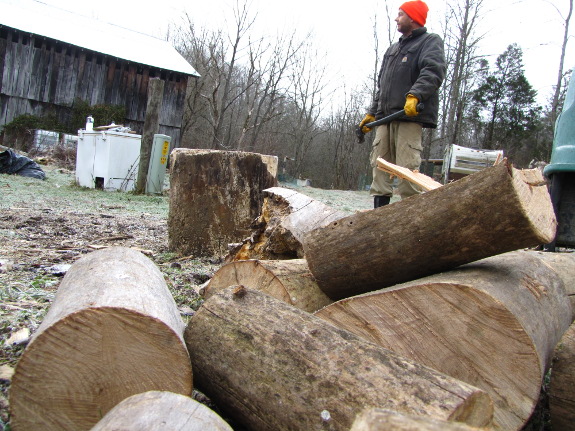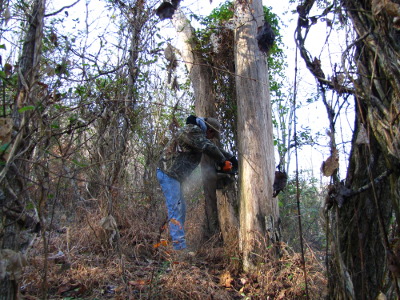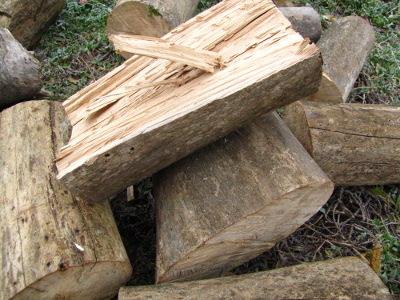
Sycamore firewood

Remember that locust
tree I'd been saving
as firewood insurance? It wasn't what I thought it was.
 Black
locust is considered to be top-notch firewood because you get 112% as
much heat out of a same-sized log compared to red or white
oaks. In contrast, the most common trees Mark and I cut out
of our woods give only 75% (box-elder) to 83% (black walnut) as much
heat as oak, which means more work for less reward. Effort aside,
oak and locust fires are preferred because they keep going longer into
the night and put off more heat in the process.
Black
locust is considered to be top-notch firewood because you get 112% as
much heat out of a same-sized log compared to red or white
oaks. In contrast, the most common trees Mark and I cut out
of our woods give only 75% (box-elder) to 83% (black walnut) as much
heat as oak, which means more work for less reward. Effort aside,
oak and locust fires are preferred because they keep going longer into
the night and put off more heat in the process.
Unfortunately, I'm
reanalyzing that standing dead tree and figuring it might be sycamore,
which clocks in at only 80% as good as oak. I'm not sure why I
didn't take the multiple trunks into account before, which is a growth
habit common in sycamores but rare in black locusts. I guess I
thought the way the logs were so darn tough to split meant they were
locust, but it turns out sycamore has a spiral grain that makes
splitting a bear.
 The easiest way to guess how
many BTUs you'll get out of a log of mystery firewood is to wait until
it's totally dry and pick it up. The lighter the wood, the less
heat you're going to enjoy when the wood burns. Bone-dry
box-elder is nearly as light as balsa wood, and our mystery tree isn't
much heavier. Meanwhile, both box-elder and our mystery wood work
great as kindling, which is another sign of low BTU --- harder woods
are tougher to light, unless they're resinous.
The easiest way to guess how
many BTUs you'll get out of a log of mystery firewood is to wait until
it's totally dry and pick it up. The lighter the wood, the less
heat you're going to enjoy when the wood burns. Bone-dry
box-elder is nearly as light as balsa wood, and our mystery tree isn't
much heavier. Meanwhile, both box-elder and our mystery wood work
great as kindling, which is another sign of low BTU --- harder woods
are tougher to light, unless they're resinous.
The fact I've been
burning light wood all winter would explain why we've been going
through it so quickly. Luckily, the shed's still mostly full, and
Mark discovered sycamore isn't terribly hard to split if you wait until
it's 20 degrees outside. If we ever run out of fallen, dead, or
in-the-way trees and start managing a woodlot, though, sycamore isn't
going to be involved.
Want more in-depth information? Browse through our books.
Or explore more posts by date or by subject.
About us: Anna Hess and Mark Hamilton spent over a decade living self-sufficiently in the mountains of Virginia before moving north to start over from scratch in the foothills of Ohio. They've experimented with permaculture, no-till gardening, trailersteading, home-based microbusinesses and much more, writing about their adventures in both blogs and books.
Want to be notified when new comments are posted on this page? Click on the RSS button after you add a comment to subscribe to the comment feed, or simply check the box beside "email replies to me" while writing your comment.

I am a firm believer in burning whatever wood someone drives up and gives you for free. Here the road construction companies have to pay to dispose of any trees the mills won't buy. But they know they can give them to me and avoid tipping fees.
So I burn anything. I get some locust, LOTS of cedar, quite a bit of basswood, and to tell the truth- it doesn't really get so cold here that it makes a difference. If I have to put in five splits instead of three, and clean my chimney one extra time, I am OK with that. (And if you procrastinate as badly as me, it is good to know that cedar and cypress dry a lot faster than oak.)
In a perfect world though, yes, I would burn one or two year seasoned black locust and oak.